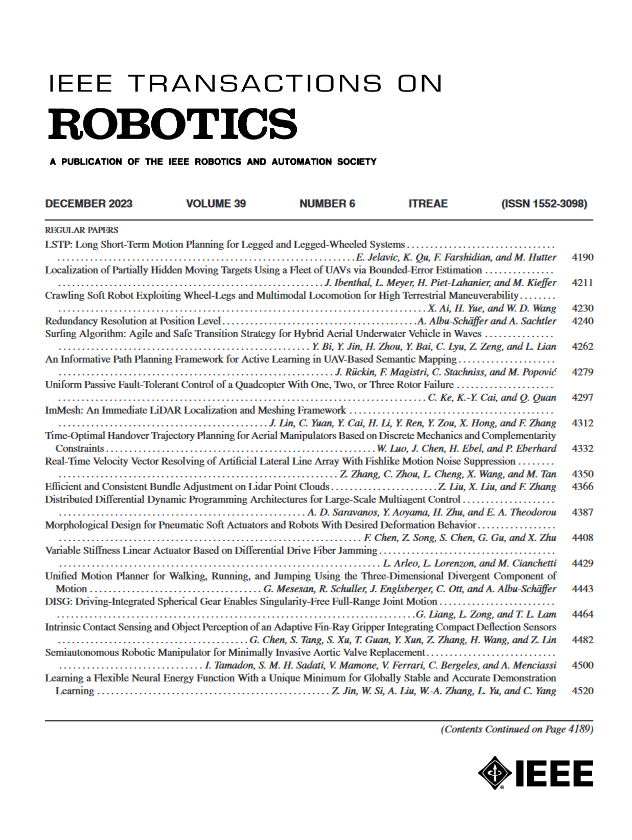由嵌入式传感仿生肌肉驱动的软体机器鱼实现自适应多模式游泳
IF 9.4
1区 计算机科学
Q1 ROBOTICS
引用次数: 0
摘要
本文章由计算机程序翻译,如有差异,请以英文原文为准。
Soft Robotic Fish Actuated by Bionic Muscle With Embedded Sensing for Self-Adaptive Multiple Modes Swimming
Fish can adaptively adjust their body kinematics and swimming modes by sensing to realize optimal propulsion. However, most soft robotic fish have an unchangeable swimming mode through simple structure design, making them difficult to adapt to dynamic and complex fluid environments. Here, inspired by the multiple muscle synergy and lateral line sensing function of fish, we developed a soft robotic fish with multiple actuating units and embedded sensing elements. By collaboratively controlling the amplitude and phase of excitation from the multiple flexible actuating units, the soft robotic fish can successfully realize various swimming modes very similar to those of natural fish. Additionally, the embedded flexible sensing elements enable the robotic fish to sense the swimming state and the surrounding fluid environment in real time. The multiple actuation and embedded sensing allow the soft robotic fish to adaptively switch to an optimal swimming mode in a certain fluid environment. The multimode swimming and perception capabilities proposed in this work not only make soft robotic fish more intelligent and adaptable to complex fluid environments, but also contribute to the future implementation of autonomous control capabilities for robotic fish.
求助全文
通过发布文献求助,成功后即可免费获取论文全文。
去求助
来源期刊

IEEE Transactions on Robotics
工程技术-机器人学
CiteScore
14.90
自引率
5.10%
发文量
259
审稿时长
6.0 months
期刊介绍:
The IEEE Transactions on Robotics (T-RO) is dedicated to publishing fundamental papers covering all facets of robotics, drawing on interdisciplinary approaches from computer science, control systems, electrical engineering, mathematics, mechanical engineering, and beyond. From industrial applications to service and personal assistants, surgical operations to space, underwater, and remote exploration, robots and intelligent machines play pivotal roles across various domains, including entertainment, safety, search and rescue, military applications, agriculture, and intelligent vehicles.
Special emphasis is placed on intelligent machines and systems designed for unstructured environments, where a significant portion of the environment remains unknown and beyond direct sensing or control.
 求助内容:
求助内容: 应助结果提醒方式:
应助结果提醒方式:


